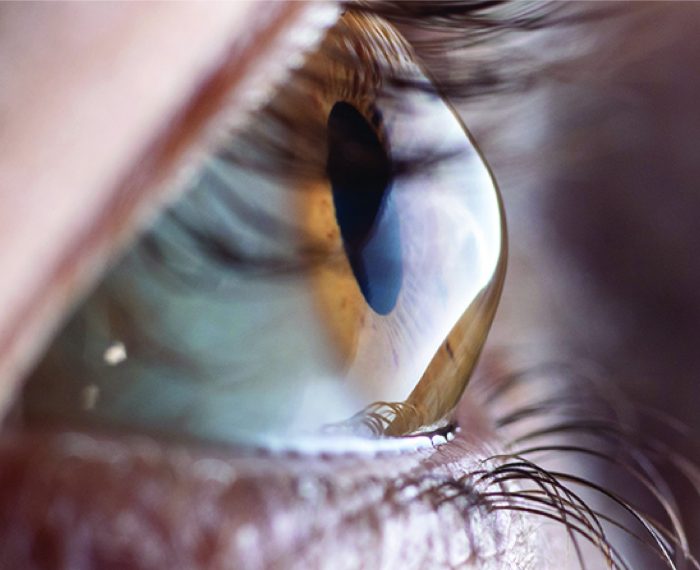
Keratoconus
Corneal Eye Disease – Keratoconus
What is Keratoconus ?
Keratoconus is an eye disease that progressively worsens over time.
- The cornea (the thin, transparent layer covering the eye) thins and begins to bulge into a cone-like shape.
- The change in the shape of the eye causes distorted vision.
What cause ?
The exact cause of keratoconus is unknown. However, there are some factors that may increase the risk of its development in an individual.
- An imbalance of certain enzymes in the cornea is said to make it more susceptible to damage by oxidative stress. This causes the cornea to become weak and may lead to keratoconus.
- Oxidative stress is when cells within the body are damaged due to an excess of free radicals.
- Free radicals occur naturally in the body but its production is accelerated in certain situations such as:
- Exposure to air pollution
- Smoking
- Alcohol
- Certain food like fried foods
- Having a family member with keratoconus may make you vulnerable to it as well (genetic predisposition).
- Excessive rubbing of the eyes e.g. in allergies.
Sign and symptoms ?
Though symptoms of keratoconus usually start in the late teens or early twenties, it can occur at any age.
- Earliest symptoms are usually blurred vision and needing to frequently change prescription glasses.
- Vision that cannot be corrected with prescription glasses.
- Sensitivity to light.
- Eyestrain and headaches.
- Appearance of “halos” around lights.
- General eye pain.
- Irritation of the eye.
How it diagnosed ?
- Keratoconus is be usually diagnosed with a slit-lamp examination. During the examination, the consultant may be able to observe:
- Thinning of the cornea
- Fleischer’s ring – an iron coloured ring surrounding a type of cell (called the cone) in the retina
- Vogt’s striae – stress lines caused by the thinning cornea
- Apical scarring – scarring at the apex of the cone
- The curvature of the cornea is then measured by corneal topography, a computerized instrument that makes 3-D maps of the cornea. This allows the consultant to observe details of the cornea and its condition.
How Keratoconus treated ?
This depends on the severity and prognosis of the condition.
- If diagnosed early, the treatment would be prescription glasses or contact lens that may improve vision.
- There are contact lens that are specially designed to correct mild-to-moderate keratoconus.
- In cases when the condition is progressing rapidly, collagen cross-linking may help to stop or slow its progress.
- Collagen cross-linking helps by strengthening the cornea.
- The procedure involves application of a riboflavin (a type of vitamin B) solution to the eye.
- This is then activated using ultraviolet (UV) light.
- The activation causes new bonds to form across the collagen in the cornea, which strengthens it.
- If the cornea has an irregular shape, a procedure called intra-corneal ring insertion may help reverse its symptoms by flattening and thickening the cornea.
- These rings are made of synthetic material and are implanted into the corneal stroma.
- The corneal stroma is a very thin, dense layer of connective tissue within the cornea.
- When implanted, the rings help to change the geometry and refractive power of the cornea.
- In end-stage keratoconus, corneal transplant surgery is considered as the last resort, once all other treatment options have been tried and failed.
- This surgery replaces the damaged or diseased cornea with a new cornea.
Corneal Collagen Cross-Linking
Cross linking of the cornea is a minimal invasive surgical treatment, based on collagen cross linking with Ultraviolet A (UVA, 365nm) and riboflavin (Vitamin B 2), a photosensitizing agent. The riboflavin, when activated by approximately 30 minutes of illumination with UV-A light, augments the collagen cross-links within the stroma and so recovers some of the cornea’s mechanical strength. The aim of this treatment is to create additional chemical bonds inside the corneal stroma by means of a highly localized photopolymerization. This changes the intrinsic biomechanical properties of the cornea, increasing its strength by almost 300%. This increase in corneal strength has shown to arrest the progression of keratoconus in numerous studies all over the world.
 The figures above show the corneal layers (parallel) and the collagen cross-linking (vertical) which increased after treatment
The figures above show the corneal layers (parallel) and the collagen cross-linking (vertical) which increased after treatment
 Stiffening effect of the treatment
Stiffening effect of the treatment
The indications for cross-linking today are corneal ectasia disorders such as keratoconus and pellucid marginal degeneration, iatrogenic keratectasia after refractive lamellar surgery, and corneal melting that is not responding to conventional therapy.
The History :
The procedure was developed from 1993 till 1997 by Prof. Theo Seiler and Prof. Eberhard Spoerl at the University of Dresden, Germany. First patients were treated in 1998. Today corneal cross-linking is performed in many centres around the world. Thousands eyes have been cross-linked world wide in controlled clinical studies with a follow up of up to 10 years.
Clinical studies have shown a significant increase in best corrected visual acuity (BCVA) in more than 85% of the treated eyes. Six months after corneal cross-linking the refractive cylinder was reduced in over 80% of the eyes. The steepest K-value was usually decreased by 1 diopter and the percentage of eyes that had a clinical relevant reduction exceeds 86%.
Safety :
Corneal cross linking is considered to be a safe procedure, provided the recommended safeguards are observed.
Minimum corneal thickness has to be 400 µ after removal of the epithelium. This is intended to protect the corneal endothelium from UV-A radiation. A 400 µ cornea soaked with riboflavin absorbs about 95% of the total radiation so that only a small amount reaches the endothelium.
Keratoconus is a disease with an uncertain cause, and its progression following diagnosis is unpredictable. The deterioration and further progression of the disease may lead to a need for cornea transplant. It is estimated that eventually 21% of the keratoconus patients require surgical intervention to restore corneal anatomy and eyesight.
Corneal cross linking has been shown to slow or arrest the progression of keratoconus, and in some cases even reversed it. This procedure has become the standard treatment for keratoconus thus preventing the need for corneal transplantation in majority of cases.
In conclusion, early treatment with this procedure will enormously reduce the need for future corneal transplantation for many of the keratoconus patients. It will be a great relief to our current shortage of available corneal tissues for transplantation.
Recent advances in Corneal Transplantation:
 The cornea is the gateway of the external images into the eye. It is a transparent tissue that forms the front part of the eye (Figure 1). It is a highly specialized tissue that refracts and transmits light to the lens and retina. If this tissue is diseased or injured, it may turn cloudy or opaque and prevent light from entering into the eye. It may be severely damaged that it perforates and may lead to losing of the entire eyeball and blindness.
The cornea is the gateway of the external images into the eye. It is a transparent tissue that forms the front part of the eye (Figure 1). It is a highly specialized tissue that refracts and transmits light to the lens and retina. If this tissue is diseased or injured, it may turn cloudy or opaque and prevent light from entering into the eye. It may be severely damaged that it perforates and may lead to losing of the entire eyeball and blindness.
Cornea transplantation is a procedure in which the diseased cornea is replaced with healthy corneal tissue (Figure 2). The objectives of corneal transplantation, depending on the corneal pathology present, may include one or more of the following: (1) establish a clear central cornea/visual axis (Figure 3), (2) minimize refractive error (Figure 4), (3) provide structural support (Figure 5), (4) alleviate pain (Figure 6), and (5) eliminate infection (Figure 7).
Corneal transplantation is one of the most successful types of organ transplantation and is the most frequently performed transplant procedure in this country. In Malaysia, corneal transplantation began in the 70s. The first corneal transplantation was performed in Hospital Kuala Lumpur. Since then, the number of transplant cases increases gradually. Every year, hundreds of corneal transplantations were performed in Malaysia. Patients with corneal diseases no longer need to seek expensive treatment overseas. Most of the different types of corneal transplantation can be performed in Malaysia with a fraction of the cost pay in overseas.
Advancements in microsurgical techniques, eye banking as well as early recognition and effective treatment of graft rejection have led to very high success rates in achieving and maintaining optical clarity in corneal graft.
A number of combination procedures at the time of transplantation have greatly improved the graft survival as well as maximized potential visual acuity, these include corneal transplantation with glaucoma surgery (Figure 8), corneal transplantation with limbal stem cell transplantation and corneal transplantation with intraocular lens implantation (Figure 9).
There are cases of corneal problems that only affecting the front part of the tissue, these include corneal scarring from previous infection, Keratoconus, opaque cornea from dystrophies or abnormal shape cornea after laser refractive surgery. These are some of the cases that can undergo partial thickness corneal transplantation that called deep anterior lamellar keratoplasty . This procedure involves the transplantation of non-viable donor corneal tissue and preserves the recipient’s corneal endothelial cells. This procedure virtually eliminates the risk of graft rejection and simplifies post-op management.
Most of the corneal blindness come from damages happened to the back part of the cornea from previous eye surgeries such as complicated cataract surgery and some hereditary diseases such as Fuch’s dystrophy. Again, partial thickness corneal transplantation that involves only the back part of the cornea such as Descemet stripping automated endothelial keratoplasty (DSAEK) or Descemet membrane endothelial keratoplasty (DMEK) is performed to improve patients’ vision. Partial thickness transplantation is preferred because of the following advantages:
- Shorter surgical time and mostly perform under local anaesthesia
- Faster post operative recovery
- More predictable refractive outcome
- Less incidence of graft rejection
Previously, the single most common obstacle for a patient to undergo corneal transplantation is difficulty in getting donor corneal tissue. This issue is largely resolved due to the availability of imported corneal tissue. Typically, the waiting time for this surgery is between two weeks to two months.









